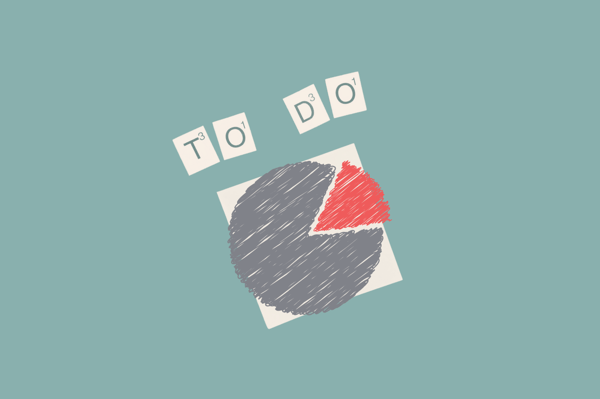Prioritizing tasks with ADHD can feel like a minefield. Not only do ADHDers often procrastinate, but we can also struggle with time blindness, task paralysis, and task avoidance. It's a vicious cycle.
So, can ADHDers learn to prioritize and improve their task management? The 80/20 rule, or the idea that 80% of results come from 20% of the effort, can be an effective tool to help organize your schedule and make time for what you actually want to do. Let's dive in.
Too long; didn't read
- The 80/20 rule, also known as the Pareto principle, says that 80% of the outcome will come from 20% of the work.
- People with ADHD often struggle with decision-making, planning, and prioritization skills, which can be addressed with the 80/20 rule.
- Applying the 80/20 rule can help you identify which tasks to prioritize and achieve more with less.
What is the 80/20 rule?
The 80/20 rule (aka the Pareto principle) suggests that 80% of the results come from 20% of the effort put in. Italian economist Vilfredo Pareto introduced this idea in the 19th century after observing that 20% of the pea pods in his garden produced 80% of the peas. He later realized that approximately 80% of Italy's land belonged to 20% of the population, affirming his idea.
In the 2000s, author Richard Koch expanded upon Pareto's idea, noting that 80% of outcomes stem from 20% of our efforts. Koch altered the idea from a mathematical rule into a loose principle that could help people achieve more output with less input.
Examples of the Pareto principle in daily life:
- 80% of software glitches are caused by 20% of bugs.
- 80% of pollution originates from 20% of all factories.
- 20% of cleaning efforts result in an 80% improvement in home appearance.
- 20% of my wardrobe is worn 80% of the time.
So, 20% of the time spent studying, completing work, or household chores should translate to 80% of the results you see. Essentially, applying this principle can help you to increase productivity by identifying which actions fit into that 20% category and prioritizing those when making your to-do list.
Why productivity is a struggle with ADHD
Executive dysfunction, a common challenge for ADHDers, makes identifying and prioritizing critical tasks difficult. Several ADHD traits can impact our ability for planning and task prioritization, as well as lead to more issues later down the line.
ADHD time blindness and planning
ADHD brains have a different time perception than neurotypical brains.1 Time blindness can cause challenges with time management and planning for bigger projects that require us to look further into the future. In everyday life, time blindness can make it hard to gauge how long a task takes to complete or how much time has passed since you last ate or took a break.
Overwhelm and task paralysis
Since ADHDers struggle with time estimation, we tend to create overly ambitious to-do lists and then feel utterly overwhelmed, unsure where to begin. Having too many things on your plate can lead to task paralysis, where you don't feel able to start anything at all.
Studies show that students with ADHD often need to work harder and longer than their neurotypical peers because of difficulties in meeting productivity expectations.2
Task avoidance and procrastination
Feelings of overwhelm often lead to anxiety, making it even harder to access the important executive functioning skills needed to prioritize and complete tasks.
A common coping mechanism for an anxious brain is to revert to procrastination, task avoidance, or procrastivity, which can further compound the vicious cycle.
So, learning to prioritize with ADHD is vital, and applying the 80/20 rule can be a lifesaver for ADHD brains.
Using the 80/20 rule to increase ADHD productivity
If you frequently allocate more than 20% of your time to less important tasks, you might overwork yourself and not have the energy left for your real priorities.
Applying the 80/20 rule can allow you to identify high-yielding critical tasks that give you more output for your efforts.
First, ask yourself these questions to assess your to-do list:
- How urgent is this task? When is the due date?
- If I fail to complete this task on time, will that affect anyone else?
- Are any tasks dependent on this one? (Tasks that can’t be started until this task is complete)
- How familiar am I with this task? Does it require learning something new?
- How does this fit my goals?
Work backwards to apply the 80/20 rule and make your efforts count:
1. Output: Identify the desired result for your task.
For example, suppose you need to write a report for an upcoming meeting. Your desired result would be to finish the report with enough time to (1) review it and (2) send copies to your colleagues or supervisor before the meeting.
2. Input: Find your 20% by identifying the most important parts of the desired result and reducing it to the essentials.
Consider what the report needs - as a bare minimum - before it can be submitted. For instance, it might require a brief overview providing context, a section illustrating data or findings, or a summary of key takeaways. Additionally, you'll need to include an outlook on how this fits into the broader context of the work your team is doing. These tasks are your 20%.
3. Decide on a reasonable time frame to complete your tasks.
The time frame will vary depending on the desired result. However, it's important to be mindful of how you allocate your time. There may be better uses of your time than spending excessive hours on non-essential tasks. Aim to prioritize the tasks that contribute significantly to the desired result.
4. Eliminate non-essential tasks from your to-do list. (Or put them on your personal to-don't list.)
What are typical time-wasters for you? Using the above situation as an example, time-wasters might be:
- Getting lost in tiny details, like clicking through countless color palettes for bar graphs
- Unnecessarily rewriting, rewording, and rephrasing paragraphs.
Eliminate or minimize these non-essential tasks that don't significantly contribute to your desired result.
By doing so, you'll free up valuable time to focus on the tasks that matter. Of course, this also gives you time for those quick, dopamine-hitting tasks that only take a few minutes and efficiently shorten your to-do list. Or, you know… take a well-deserved break.
Final thoughts
Next time you go through your to-do list, try applying the 80/20 rule to help combat task avoidance and task paralysis. It can be a valuable exercise to help you understand yourself and your priorities. Remember: It's okay that prioritization is a challenge for your ADHD brain. Reframing the narrative is always more empowering than coming at it from the point of frustration.
Sources
1 Medical Science Monitor | Clinical Implications of the Perception of Time in Attention Deficit Hyperactivity Disorder (ADHD): A Review (2019)
2 Dyslexia and Comorbid Disorders: Transdisciplinary Assessment and Treatment | Strategies for Coping with Time-Related and Productivity Challenges of Young People with Learning Disabilities and Attention-Deficit/Hyperactivity Disorder (2019)








